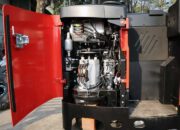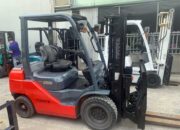Selling and Renting 6m High-Lift Forklifts
The 2m, 3m, 6m high-lift forklift is an industrial material handling vehicle designed to lift and move items, pallets, or goods to heights of approximately 2 meters, 3 meters, or 6 meters. It plays a crucial role in the industrial and logistics sectors, optimizing storage and transportation of goods in warehouses, manufacturing plants, supermarkets, and various industrial environments.
Here are some common features and important information about 2m, 3m, 6m high-lift forklifts:
Lifting Capacity: These forklifts are capable of lifting loads to heights of about 2 meters, 3 meters, or 6 meters, making them suitable for working in warehouses with low to medium ceiling heights.
Forklift Types: 2m, 3m, 6m high-lift forklifts come in various types, including stand-up forklifts, sit-down forklifts, or compact stand-on models. The choice depends on the working environment and specific job requirements.
Productivity: These forklifts are known for their quick and efficient lifting capabilities, enhancing productivity in warehouses or manufacturing facilities.
Safety: To ensure the safety of operators and those around them, 2m, 3m, 6m high-lift forklifts are equipped with safety features such as braking systems, warning lights, audible alarms, and safety switches.
Controls: Operators can control the forklift manually or through automatic control systems, depending on the type of forklift.
Fuel: High-lift forklifts can run on various fuels, including gasoline, diesel, electric, or natural gas.
Wheels: These forklifts can have standard wheels or specialized load-bearing wheels, depending on the working environment.
Maintenance: Regular maintenance and pre-use inspections are essential to ensure safe and efficient operation.
2m, 3m, 6m high-lift forklifts play a vital role in managing goods and optimizing logistics services. Selecting the appropriate type of forklift and ensuring safe and efficient use is crucial to enhance productivity and minimize risks in industrial settings.
Applications for 2m, 3m, 6m High-Lift Forklifts
The need for 2m, 3m, 6m high-lift forklifts often arises from various industries and different work environments. Here are some key needs that 2m, 3m, 6m high-lift forklifts can address:
Warehouse Management: High-lift forklifts are essential tools for managing and organizing goods in warehouses and manufacturing plants. They have the capability to lift pallets and goods to high shelves, optimizing storage space.
Construction and Building: In the construction industry, 2m, 3m, 6m high-lift forklifts can be used to transport and lift construction materials such as cinder blocks, concrete building materials, and even workers at elevated heights.
Industrial Manufacturing: Manufacturing plants often use forklifts to move components and finished products during the production process. 2m, 3m, 6m high-lift forklifts enhance efficiency and reduce handling time.
Logistics and Distribution: In the logistics and distribution industry, these forklifts are used to lift and stack goods onto trucks and containers for transportation. They are also useful for organizing goods in distribution centers.
Food Industry and Supermarkets: In the food industry and supermarkets, forklifts are used to lift and move goods from the warehouse to the shelves for display or to replenish stock.
Maintenance and Repairs: In environments requiring maintenance and repairs, 2m, 3m, 6m high-lift forklifts can transport tools, equipment, and materials necessary for maintenance tasks.
Height-Related Work: Some tasks require workers to operate at elevated heights, such as installing lights, security cameras, or roof repairs. High-lift forklifts provide support for these tasks.
Therefore, 2m, 3m, 6m high-lift forklifts have diverse applications across various industries, from warehouse management to manufacturing, construction, logistics, and many other industrial sectors. Choosing the right type of forklift to meet your specific needs and ensuring safe usage is essential for optimizing work performance.
Highlighting the Benefits of Using 2m, 3m, 6m High-Lift Forklifts
Using 2m, 3m, 6m high-lift forklifts offers several important benefits to industries and workplaces. Here are the key advantages of using these forklifts:
Space Optimization: High-lift forklifts enable the lifting of goods to greater heights, allowing for efficient use of storage space and the creation of multi-level storage racks, saving space and optimizing goods arrangement in warehouses.
Increased Productivity: These forklifts can lift and move goods quickly and efficiently, enhancing work productivity and reducing the time required for lifting, transportation, and storage processes.
Workplace Safety: High-lift forklifts are designed with safety features such as braking systems, warning lights, alarms, and sensors to ensure the safety of operators and those working in close proximity. This helps reduce the risk of workplace accidents and injuries.
Height Access Capability: High-lift forklifts enable access and work at elevated heights, facilitating tasks such as repairs, maintenance, installation, and operation in hard-to-reach locations.
Reduced Manual Labor: Using forklifts reduces the physical effort required to lift and move goods, helping to reduce fatigue and injuries among workers.
Enhanced Transportation Efficiency: In the logistics industry, 2m, 3m, 6m high-lift forklifts facilitate the loading and unloading of goods onto trucks or containers, optimizing the transportation process and reducing the time needed for loading and unloading.
Time and Resource Savings: Using high-lift forklifts saves time in lifting and moving operations, optimizing work scheduling and overall business performance.
Increased Flexibility: High-lift forklifts can be used in various work environments and for different types of goods, offering flexibility in goods management and transportation.
In summary, using 2m, 3m, 6m high-lift forklifts not only optimizes work processes but also ensures safety and enhances overall efficiency in industrial and logistics environments.
Introduction to Samcovina Joint Stock Company – Your Reliable Forklift Partner
Samcovina Joint Stock Company has established itself as a professional entity specializing in the sale and rental of electric and diesel forklifts with lifting capacities of 2m, 3m, and 6 meters. With over a decade of experience, Samcovina takes pride in being a trustworthy and reliable partner in the forklift industry in Vietnam.
Our Mission
The mission of Samcovina Joint Stock Company is to provide perfect forklift solutions for customers from various industries. We are committed to ensuring that all customers receive the highest level of support and service to optimize their operations.







